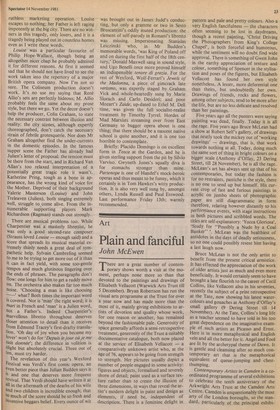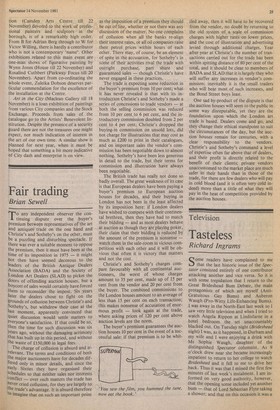Art
Plain and fanciful
John McEwen
There are a great number of contemporary shows worth a visit at the moment, perhaps none more so than that devoted to the paintings and drawings of Elisabeth Vellacott (Warwick Arts Trust till 5 December). Bryan Robertson has run the visual arts programme at the Trust for over a year now and has made more than the most of it, mainly giving exhibitions to artists of devotion and quality whose work, for one reason or another, has remained beyond the fashionable pale. Generosity of space generally affords a semi-retrospective treatment, generosity of the Trust a suitably documentative catalogue, both now placed at the service of Elisabeth Vellacott — a comparatively unknown artist who, at the age of 76, appears to be going from strength to strength. Her pictures usually depict a number of people engaged in some activity: figures and objects, formalised and severely shorn of detail; paint used as a surface texture rather than to create the illusion of three dimensions, in ways that reveal the artist's modern delight in paint and design as elements, if need be, independent of description. There is a feminine delight in pattern and pale and pretty colours. Also a very English fancifulness — the characters often seeming to be lost in daydreams, though a recent painting, 'Christ Driving the Photographers from King's College Chapel', is both forceful and humorous, while the sentiment will no doubt find wide approval. There is something of Gwen John in the earthy appreciation of texture and colour, something of Spencer in the stylisation and poses of the figures, but Elisabeth Vellacott has found her own style nonetheless. A lesser, more deferential one than theirs, but undoubtedly her own. Drawings of friends, rocks and flowers, among other subjects, tend to be more after the life, but are no less delicate and resolved than her paintings.
Five years ago all the punters were saying painting was dead, finally. Today it is all the rage. Five years ago Bruce McLean had a show at Robert Self's gallery, of drawings that neatly took the mickey out of 'working drawings' — drawings, that is, that work towards nothing at all. Today, doing much the same sort of thing in bright colours on a bigger scale (Anthony d'Offay, 23 Dering Street, till 28 November), he is all the rage. McLean's art has always sent up that of his contemporaries, but today the fashion is for no restraints, pastiche is the style, there is no one to send up but himself. His current crop of fast and furious paintings in acrylic on jumbo sheets of photographic paper are still diagrammatic in form therefore, relating however distantly to his performance events, with stage instructions in both pictures and scribbled words. The titles are self-explanatory: 'Yucca Gloriosa', 'Study for "Possibly a Nude by a Coal Bunker" '. McLean was the healthiest of antidotes in the days of deadly seriousness, so no one could possibly resent him having a last laugh now.
Bruce McLean is not the only artist to benefit from the present critical armistice. It has effected the appreciation of the work of older artists just as much and even more beneficially. It would certainly seem to have brought a late flourish to the career of Cecil Collins, like Vellacott also in his seventies, recently the subject of a print retrospective at the Tate, now showing his latest watercolours and gouaches at Anthony d'Offay's small gallery (9 Dering Street till 14 November). At the Tate, Collins's long life as a teacher seemed to have told in his too great dependence on the imaginative example of such artists as Picasso and Ernst. Here is in more metaphysical and English vein and all the better for it. Angel and Fool are lit by the archetypal theme of Dawn. It is gentle and cleansing after so much contemporary art art that is the metaphorical equivalent of queue-jumping and chestthumping.
Contemporary Artists in Camden is a coordinated programme of several exhibitions to celebrate the tenth anniversary of the Arkwright Arts Trust at the Camden Arts Centre. Camden is unquestionably the most arty of the London boroughs, so the standard, particularly of the principal exhibi tion (Camden Arts Centre till 22 November) devoted to the work of professional painters and sculptors in the borough, is of a remarkably high order. From B for Adrian Berg through to W for Victor Willing, there is hardly a contributor who is not a contemporary 'name'. Other exhibitions related to this main event are one-man shows of figurative painting by Wynn Jones (House till 22 November) and Rosalind Cuthbert (Parkway Focus till 20 November). Apart from co-ordinating the whole event, Zuleika Dobson deserves particular commendation for the excellence of the installation at the Centre.
Art in the City (Maclean Gallery till 18 November) is a loan exhibition of paintings from various City companies and the Stock Exchange. Proceeds from sales of the catalogue go to the Artists' Benevolent Institution. Despite the presence of a security guard there are not the treasures one might expect, nor much indication of interest in the art of our own time. A similar show is planned for next year, when it must be hoped that something a bit more indicative of City dash and enterprise is on view.



































 Previous page
Previous page